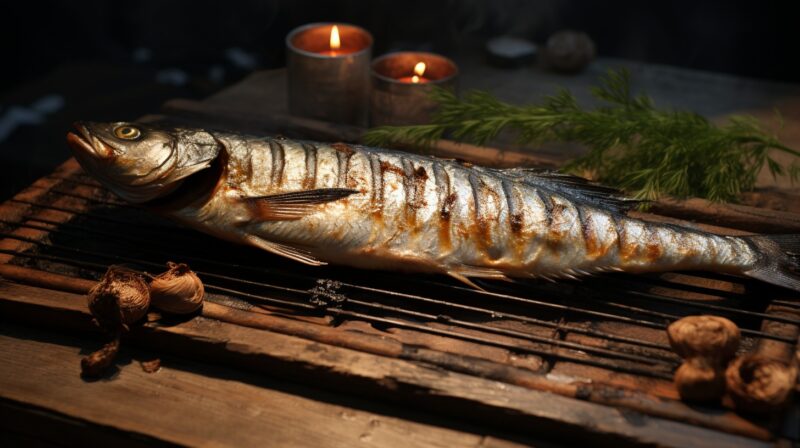
One of my most cherished memories is from a serene morning spent on a wooden boat, surrounded by the vast expanse of the ocean. As the sun began to rise, casting a soft glow on the water, I watched as seasoned fishermen skillfully cast their nets, hoping for a bountiful catch.
To my delight, they pulled up a shimmering school of mackerel, their silvery scales reflecting the morning light. Later, as we sat on the shore, a freshly grilled piece of that very fish was handed to me. The taste was unparalleled—rich, oily, and utterly divine.
With all their characteristics, mackerel truly represent crucial food in many cultures. Let us see all the most relevant information about this fish.
The Flavor Profile
Mackerel is known for its rich and oily texture. This oiliness gives it a mouthfeel that’s both smooth and luscious. When cooked, the oils in the fish melt, releasing a burst of flavors that are both savory and slightly sweet. This unique combination is what sets it apart from many other fish.
Being a saltwater fish, it naturally has a salty undertone. This saltiness is subtle, but it enhances the overall flavor of the fish. When paired with the right seasonings, this saltiness can be a delightful addition to many dishes.
Unlike some other fish, it doesn’t have an overpowering fishy taste. Instead, its flavor is mild and delicate, making it a great choice for those who aren’t fans of strong fishy flavors. This mildness also allows mackerel to be versatile in various culinary applications.
Comparison to Other Fish
Now that we’ve established the basic flavor profile of mackerel, let’s see how it stacks up against other popular fish.
- Salmon: Another oily fish, is often compared to mackerel. While both have a rich texture, salmon tends to be milder in flavor. On the other hand, it has a more pronounced taste, thanks to its salty undertones. Both fish are excellent sources of omega-3 fatty acids, making them nutritious choices.
- Tuna: Tuna is meatier and less oily. While both fish have a deep, savory flavor, the oiliness gives it a unique edge. Tuna’s meaty texture makes it a favorite for steaks and sashimi, while its delicate nature is perfect for grilling or broiling.
- Sardines: Sardines, canned or fresh, and mackerel are often confused due to their similar size. Sardines have a stronger fishy flavor and are less oily. The mild taste and rich texture make it more versatile in cooking, while sardines are often enjoyed straight from the can or lightly grilled.
Culinary Uses
Mackerel’s unique taste and texture make it a favorite in many cuisines. As you can imagine, there are countless options worldwide. Here you will find some of the most interesting ones.
- Grilled: Grilling enhances fish’s natural flavors. The high heat caramelizes the fish’s natural sugars, giving it a slightly sweet and smoky taste. Paired with a squeeze of lemon or a drizzle of olive oil, grilled one is a treat for the taste buds.
- Sashimi: In Japanese cuisine, mackerel sashimi is a delicacy. The fish’s oily texture makes it perfect for raw consumption. When sliced thinly and served with a dab of wasabi and soy sauce, sashimi is a melt-in-your-mouth experience.
- Curry: In some cultures, mackerel is used to make rich and flavorful curries. The fish’s oiliness blends well with spicy and tangy sauces, creating a dish that’s both hearty and delicious. Paired with rice or bread, curry is comfort food at its best.
- Tartare: A contemporary take on the classic steak tartare, tartare combines finely chopped fresh mackerel with ingredients like avocado, lime juice, and fresh herbs. Served with crispy toast or crackers, it’s a refreshing appetizer that’s sure to impress.
- Citrus Salad: Pairing mackerel with citrus fruits like orange or grapefruit can elevate its flavor. The acidity of the citrus cuts through the oiliness of the fish, creating a balanced and vibrant dish. Toss in some fresh greens, and you have a light and nutritious salad.
- Smoked Risotto: Infusing the creamy texture of risotto with the smoky flavor of mackerel creates a dish that’s both comforting and sophisticated. With a hint of white wine and parmesan, this risotto is a delightful fusion of flavors.
Pairing with Wines
The right wine can enhance the taste, making the dining experience truly memorable. Let’s delve into the world of wine pairings suitable for dishes prepared with this one. Crisp white wines, such as Sauvignon Blanc or Albariño, complement the rich flavor.
The acidity in these wines balances the fish’s oiliness, creating a harmonious pairing. A chilled rosé, with its fruity notes, can be a delightful companion to grilled or smoked mackerel. The wine’s lightness contrasts beautifully with the depth of the fish’s flavor.
For dishes like tartare or sashimi, consider pairing with a sparkling wine. The bubbles and crispness of the wine enhance the freshness of the fish, making each bite a celebration.
The Nutrition Powerhouse

Besides its delightful taste, mackerel is a powerhouse of nutrition.
Omega-3 Fatty Acids
One of the most touted benefits of mackerel is its high content of omega-3 fatty acids. These essential fats are known to promote heart health, reduce inflammation, and support brain function.
Vitamins and Minerals
It represents a good source of essential vitamins and minerals, including vitamin B12, selenium, and iodine. These nutrients play a crucial role in maintaining overall health, from supporting metabolism to promoting immune function.
Protein-Rich
As a fish, mackerel is an excellent source of high-quality protein. Protein is vital for muscle growth, repair, and overall body function. Including it in your meals can help meet your daily protein needs while enjoying its unique flavor.
Economic Impact of Fishing
Mackerel fishing isn’t just about the culinary delights; it’s also a significant economic activity for many regions. Let’s delve into the economic implications of mackerel fishing.
Mackerel fishing provides employment to thousands, from fishermen to those in processing plants and distribution networks. For many coastal communities, fishing is the primary source of livelihood.
It definitely is a popular fish globally, making it a valuable source of income for many countries. Nations like Norway, Japan, and Canada benefit significantly from exporting it to international markets. Like any industry, mackerel fishing faces challenges.
Market fluctuations, changing consumer preferences, and environmental concerns can impact the profitability fishing, making it essential for the industry to adapt and innovate.
FAQs
Can the taste of mackerel vary based on how it’s prepared?
The preparation method can influence mackerel’s taste. For instance, grilling can enhance its natural flavors, giving it a slightly smoky taste, while it being raw in sashimi form retains its natural, delicate flavor.
Is there a specific way to season mackerel to enhance its taste?
Mackerel pairs well with a variety of seasonings. Simple seasonings like salt, pepper, and lemon can highlight its natural flavors. For those looking to experiment, it also complements stronger flavors like garlic, herbs, and various marinades.
Is mackerel an acquired taste?
While many people instantly enjoy mackerel’s unique flavor, others might take a while to appreciate its richness and nuances. Like many foods, individual preferences play a significant role.
How does the freshness of mackerel impact its taste?
Freshness is crucial when it comes to mackerel. Fresh one has a clean, ocean-like taste, while older fish can develop a stronger, fishier flavor. Always opt for the freshest ones for the best taste experience.
Can the diet and habitat of mackerel influence its flavor?
Yes, the diet and habitat can affect its taste. Mackerel that feed on a diverse diet in clean, cold waters often have a richer and more refined flavor compared to those from warmer or polluted waters.
Wrapping Up
As my story comes to a close, I’m transported back to that tranquil morning on the boat, the excitement of the catch, and the unforgettable taste of freshly grilled mackerel. It’s evident that mackerel isn’t just a fish; it’s a symphony of flavors, stories, and traditions.
From its unique taste profile to its cultural and historical significance, it has left an indelible mark on the culinary world.
Related Posts:
- What Does Walleye Taste Like? Diving into the Deliciousness
- What Does Lamb Taste Like? Know This Before You Try!
- What do Lentils Taste Like? What Should I Expect? -…
- What Do Anchovies Taste Like: A Flavor Expedition
- From Earth to Plate: A Culinary Adventure into the…
- 6 Culinary Arts Scholarships 2023-24: A Taste of Success




















